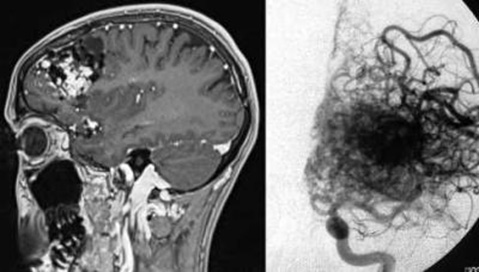Angioma – Arteriovenous Malformation (AVM)

What are angiomas?
Angiomas or arteriovenous malformations (AVMs) are usually congenital vascular malformations, which consist of a short circuit of afferent vessels (arteries) and outgoing vessels (vein).

Symptoms
By angioma different symptoms can be triggered. Often headache, seizures and paralysis, and depending on the location of the angioma also speech or memory-deficits may occur. However, the main problem with angioma is a risk of brain hemorrhage occurring spontaneously. The risk of bleeding is specified in larger studies with AV angiomas with a bleeding probability of about 1 to 2 % per year. For very large angiomas that have already been bleeding, the probability for bleeding is higher.

Distinction between symptomatic and asymptomatic angiomas
A basic distinction is made between asymptomatic angiomas, ie AV Malformation who have not bled and caused no neurological deficits, and symptomatic angiomas, whitch cause headaches, seizures or neurological deficits or have already caused a brain hemorrhage.
After the angiographic diagnosis, arteriovenous malformations (AVM) can be classified due to their size, the location and the hemodynamics by the Spetzler-Martin classification. On the basis of angiography and MRI imaging a detailed planning for the best treatment option should be done.

Treatment methods
In principle, three treatment methods are available:
– Endovascular treatment, that is, the closure of the afferent and efferent vessels with particles, adhesive glue, or with small spirals over a catheter that is introduced into the angioma
Needs: surgery, anaesthesia, hospital stay
– Radiosurgery (Cyberknife, ZAP-X), ie, targeted single irradiation of the angioma nidus, which is located in the center of the angioma. This will cause irradiation-induced closure of the angioma vessels and protection of the remaining cerebral blood flow in the long term.
Needs: outpatient procedure, painfree
– Microsurgical treatment, that is, the complete removal of the angioma with selective occlusion of the incoming and outgoing vessels while sparing the surrounding brain vessels.
Needs: surgery, anaesthesia, hospital stay

Treatment goal
Left: MRI of frontal AVM Right: DSA

The aim of the treatment is to close the angioma completely, because only in that case no further risk of bleeding is to be expected. The individual treatment method always has to be carefully considered, because not every angioma can be treated by endovascular treatment or radiosurgery or surgery with the same potential and risks. Often, the combination of different treatment methods is necessary in order to achieve an angioma closure.
Since these are complex medical aspects, it is important to discuss the various treatment options on an individual basis. At the ERCM, the individual cases are discussed in detail with the colleagues of the stroke center of the University Hospital Großhadern (LMU) at weekly neurovascular conferences.


